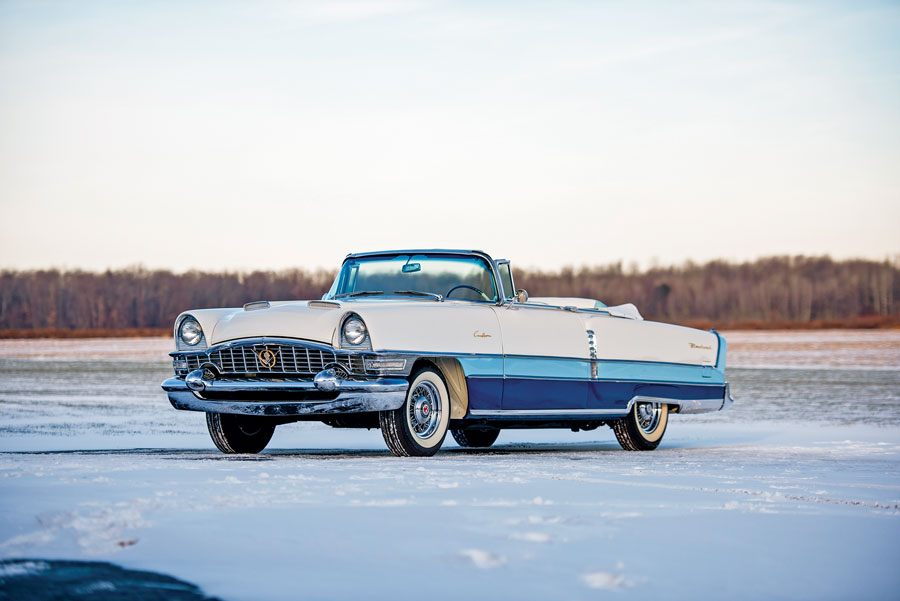- Offered from the Gernatt Collection
- 275-hp, 352-ci V8 automatic
- Frame-off restoration 2016
- White Jade, Zircon, Sapphire
- Power windows, seat, top, steering and brakes
- Clock and Wonder Bar radio
- Chrome wires, shod with wide whitewalls
- Packard’s most deluxe model for 1955 and one of only 500 produced
SCM Analysis
Detailing
| Vehicle: | 1963 Aston Martin DB4 Convertible |
| Years Produced: | 1953–56 |
| Number Produced: | 500 (1955) |
| Original List Price: | $5,932 |
| SCM Valuation: | $84,500 |
| Chassis Number Location: | Plate attached to left front door post |
| Engine Number Location: | Boss upper left side of engine block |
| Alternatives: | 1955 Cadillac Eldorado convertible, 1957 Imperial Crown convertible, 1957 Chrysler 300C convertible |
| Investment Grade: | B |
This car, Lot 353, sold for $78,100, including buyer’s premium, at RM Sotheby’s Online Only Palm Beach, FL, auction held March 20–28, 2020.
The early ’50s were an exciting time for the automotive industry. With the exception of the Raymond Loewy-designed Studebaker, manufacturers had been selling warmed-over pre-war offerings that fed pent-up demand for automobiles. But to continue to prosper, automakers realized they needed more-exciting offerings. Designers demonstrated their creativity with futuristic dream cars.
Harley Earl’s “Y-Job,” the Buick Le Sabre and the Buick XP-300 captured the public’s imagination. Cadillacs began sprouting fins as GM offerings grew lower and sleeker. General Motors, at the 1953 New York Motorama, presented the Oldsmobile Fiesta, the Cadillac Eldorado and the Buick Skylark, and the public lusted over their futuristic features and design. Just down the way, the new Corvette introduced America’s sports car.
Packard’s new look
Packard’s collection of dream cars was not as well known, but they were every bit as sensational. With prominent designer Dick Teague on staff and Dutch Darrin and Ray Dietrich on contract, Packard had the creative talent to produce their own excitement.
The striking Pan-American borrowed a few tricks from the hot-rodders of the era — it was sectioned, the door handles shaved and it was void of chrome, giving a clean, European look.
The Pan-American, due to excessive cost, never made it into production, but Richard Teague used it as the basis for the new Caribbean. He could not section the body, but he did add a scooped hood, Continental kit and radiused rear-wheel openings. The car carried a price tag of $5,250, and they sold 750, outselling the 1953 Cadillac Eldorado by 218 units.
Style and luxury
By 1955, the Caribbean was riding on a 127-inch chassis, and Teague had redesigned the car with fashionable triple-tone livery, twin scoops on the hood and functioning dual rear aerials. The only options were wire wheels, air, and tinted or shaded glass. Auto Age stated it was “America’s finest car,” although with the frequent change in advertising agencies, there was not a consistent message or theme.
Seating in the Caribbean was luxurious leather, and the car offered the soon-to-prove-unreliable Twin-Ultramatic automatic transmission, which was controlled by push buttons in the middle of the dash. Turning the key brought the new-for-’55 overhead-valve 275 horsepower V8 with twin Rochester 4-barrel carbs to life, and the car would rise slightly as the innovative electronically controlled Torsion-Level Ride suspension awoke. With this car, Packard had the dubious distinction of being the first to offer a/c in a convertible.
Packard sold 500 of the Caribbean convertibles in 1955, and even that is commendable, as the company was having numerous Black Swan moments. As an example, longtime Packard body builder Briggs had been acquired by Chrysler, so Packard was forced to produce their own bodies for these cars.
Additionally, Packard then leased Briggs’ Conner Avenue plant and moved to it from their East Grand Boulevard facility. The new Conner plant was less than a third the size of the previous location, and was poorly designed. One deficiency was that it had only one delivery door, and trucks often had to wait to deliver raw materials. Quality became an issue, and these cars had far too many ragged edges. On top of all that, Packard lost their defense business, and the merger with Studebaker was a financial disaster. The Caribbean held on for one final year, but the writing was on the wall.
This car
RM Sotheby’s sold the subject 1955 Caribbean at an online auction, which has become the New Abnormal for the foreseeable future. The car was well documented and the RM Sotheby’s specialists were available for their forthright analysis. It is a format that has proved successful for Bring a Trailer, and there is no reason that it won’t be just as successful with RM Sotheby’s.
You do, however, become a bit more of a sleuth, and the photos force you to dig further. For example, this Caribbean was stated to have benefited from a frame-off restoration in 2016, but the painted hexagon centers of the hubcaps were chipped or the paint was missing entirely. That’s an easy fix, but why was it not repaired prior to the auction? In addition, a budget battery was installed, and while that’s not a big deal, it does raise some additional questions about other things that might not have been exactly correct.
The ACC Premium Auction Database has about 100 of these cars listed — or about 20% of the total production. Prices range from $25,000 for a needs-everything example to the high five figures for a properly restored one.
Our subject car slots into the higher range, where it rightfully belongs, which is a good sign for the market in the midst of coronavirus. Online or live auction aside, this Caribbean sold for a market-correct figure for its condition, and both the buyer and seller should be pleased.
(Introductory description courtesy of RM Sotheby’s.)
